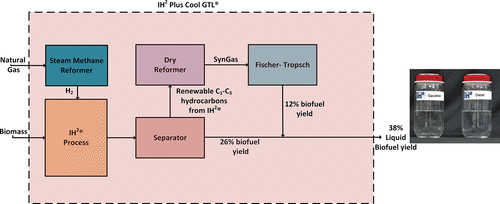当前位置:
X-MOL 学术
›
ACS Sustain. Chem. Eng.
›
论文详情
Our official English website, www.x-mol.net, welcomes your
feedback! (Note: you will need to create a separate account there.)
Carbon Footprint Analysis of Gasoline and Diesel from Forest Residues and Algae using Integrated Hydropyrolysis and Hydroconversion Plus Fischer–Tropsch (IH2 Plus cool GTL)
ACS Sustainable Chemistry & Engineering ( IF 7.1 ) Pub Date : 2018-06-30 00:00:00 , DOI: 10.1021/acssuschemeng.8b02091 Olumide Winjobi 1 , Hossein Tavakoli 2 , Bethany Klemetsrud 3 , Robert Handler 1 , Terry Marker 4 , Michael Roberts 4 , David Shonnard 1
ACS Sustainable Chemistry & Engineering ( IF 7.1 ) Pub Date : 2018-06-30 00:00:00 , DOI: 10.1021/acssuschemeng.8b02091 Olumide Winjobi 1 , Hossein Tavakoli 2 , Bethany Klemetsrud 3 , Robert Handler 1 , Terry Marker 4 , Michael Roberts 4 , David Shonnard 1
Affiliation

|
Life cycle analysis was conducted with a focus on greenhouse gas (GHG) emissions of renewable gasoline and diesel produced by the integrated hydropyrolysis and hydroconversion (IH2) and the new IH2 plus Fischer–Tropsch (IH2 Plus cool GTL) processes. This new process has a primary objective of increasing the yield of biofuel relative to original IH2 process (increase of 26% to 38% wt) by processing the C1–C3 gas co-products through an integrated Fischer–Tropsch unit to produce liquid-range hydrocarbon biofuel. For both biofuel processes, woody biomass residues (forest logging and saw mills) and algae were investigated as feedstocks. The effect of the electricity generation mix of different states in the U.S. was also examined for algae cultivation. For woody residues as feedstock, life cycle GHG emission savings of about 86.8% and 63.3% were calculated for the IH2 and optimized-IH2 Plus cool GTL hydrocarbon biofuel, respectively, relative to fossil-derived fuel. For algae as feedstock, emission increases of about 140% and 103% were calculated for the IH2 and optimized-IH2 Plus cool GTL, respectively, relative to fossil-derived fuel. The electricity grid mix of the biorefinery location significantly impacts the GHG emissions of the processes for algae feedstock. GHG savings of about 42% can be potentially achieved if the plant was located in an area with a low GHG intensity grid. This study has shown that a significant biofuel yield boost can be achieved while retaining high GHG savings by using IH2 Plus cool GTL for a woody feedstock.
中文翻译:

使用加氢热解和加氢转化费-托(IH 2 Plus冷却GTL)进行森林残留物和藻类中汽油和柴油的碳足迹分析
生命周期分析的重点是通过加氢热解和加氢转化(IH 2)和新的IH 2 +费-托(IH 2 Plus冷GTL)工艺生产的可再生汽油和柴油的温室气体(GHG)排放。该新工艺的主要目的是相对于原始IH 2提高生物燃料的产量通过集成的费-托装置处理C1-C3气体副产物来生产液程碳氢化合物生物燃料的过程(增加26%至38%wt)。对于这两种生物燃料过程,都对木质生物质残留物(森林砍伐和锯木厂)和藻类作为原料进行了研究。还研究了美国不同州的发电混合对藻类种植的影响。对于木质残留物作为原料,相对于化石衍生燃料,分别计算出IH 2和优化的IH 2 Plus冷GTL碳氢化合物生物燃料的生命周期温室气体排放量分别节省了约86.8%和63.3%。对于藻类作为原料,计算出的IH 2和优化的IH 2排放量分别增加了140%和103%相对于化石衍生燃料,还要分别加上凉爽的GTL。生物精炼厂所在地的电网结构显着影响藻类原料工艺过程的温室气体排放量。如果工厂位于温室气体强度较低的区域,则有可能实现约42%的温室气体节省。这项研究表明,通过使用IH 2 Plus凉爽GTL作为木质原料,可以在显着提高生物燃料产量的同时保持较高的温室气体节省量。
更新日期:2018-06-30
中文翻译:

使用加氢热解和加氢转化费-托(IH 2 Plus冷却GTL)进行森林残留物和藻类中汽油和柴油的碳足迹分析
生命周期分析的重点是通过加氢热解和加氢转化(IH 2)和新的IH 2 +费-托(IH 2 Plus冷GTL)工艺生产的可再生汽油和柴油的温室气体(GHG)排放。该新工艺的主要目的是相对于原始IH 2提高生物燃料的产量通过集成的费-托装置处理C1-C3气体副产物来生产液程碳氢化合物生物燃料的过程(增加26%至38%wt)。对于这两种生物燃料过程,都对木质生物质残留物(森林砍伐和锯木厂)和藻类作为原料进行了研究。还研究了美国不同州的发电混合对藻类种植的影响。对于木质残留物作为原料,相对于化石衍生燃料,分别计算出IH 2和优化的IH 2 Plus冷GTL碳氢化合物生物燃料的生命周期温室气体排放量分别节省了约86.8%和63.3%。对于藻类作为原料,计算出的IH 2和优化的IH 2排放量分别增加了140%和103%相对于化石衍生燃料,还要分别加上凉爽的GTL。生物精炼厂所在地的电网结构显着影响藻类原料工艺过程的温室气体排放量。如果工厂位于温室气体强度较低的区域,则有可能实现约42%的温室气体节省。这项研究表明,通过使用IH 2 Plus凉爽GTL作为木质原料,可以在显着提高生物燃料产量的同时保持较高的温室气体节省量。











































 京公网安备 11010802027423号
京公网安备 11010802027423号